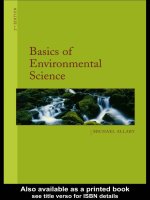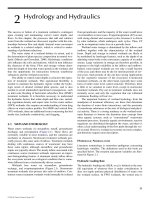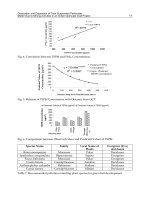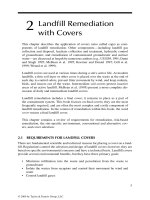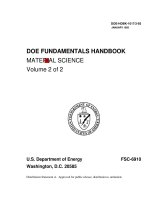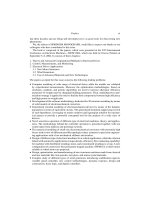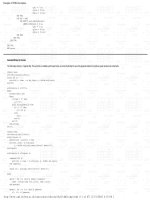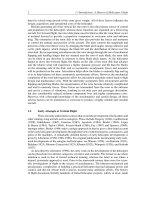BASICS OF CONCRETE SCIENCE - CHAPTER 2 docx
Bạn đang xem bản rút gọn của tài liệu. Xem và tải ngay bản đầy đủ của tài liệu tại đây (486.26 KB, 14 trang )
CHAPTER 2
CONCRETE MIXTURES
L. Dvorkin and O.Dvorkin
2.1. Structure and rheological properties
Concrete mix is a system in which cement paste and water bind aggregates such
as sand and gravel or crushed stone into a homogeneous mass.
The coefficient of internal friction relies mainly on the coarseness of aggregates
and can be approximately calculated on the Lermit and Turnon formula:
b
f = lg ad ,
(2.1)
where d - middle diameter of particles of
aggregate; a and b - constants.
The rheological model of concrete mixture is usually characterized by
the Shvedov-Bingam formula:
τ = τ max + η m
dV
,
dx
(2.2)
where τ max – maximum tension; ηm – plastic viscidity of the
system with the maximum destructive structure; dV/dx – gradient
of speed of deformation during flow.
41
a
b
τmax
τmax
Fig. 2.1. Change of viscidly-plastic properties of concrete mixture
depending on tensions:
a – change of structural viscosity; b – change of speed of deformation of
flow (αo and αm – corners, which characterizing coefficients of viscosity of
the system);
τmax – maximum tension; ηo ηm – plastic viscosity of the system accordingly with
nondestructive and destructive structure
42
The conduct of concrete mixtures at vibration approximately can be
described by Newton formula :
τ = ηm
dV
.
dx
(2.3)
τmax
τmax
Fig. 2.2. Chart of
rheological model of
Bingam
Fig. 2.3. Chart of the
rheological model of
Shefild-Skot-Bler
43
η, Pa⋅sec
sm/sec
sm/sec
Fig. 2.4. Dependence of
structural viscosity of concrete
mixture on:
1- speed (v); 2 - reverse speed
of vibrations (1/v)
C/W
Fig. 2.5. Dependence of viscosity of
concrete mixture on cement – water ratio
(C/W):
1 – from formula (2.4);
2 – from A.Desov experimental data
44
Influencing of concentration of dispersed phase (ϕ) on viscosity of colloid
paste (η) at first was described by A. Einstein:
η = η0 (1 + 2,5ϕ),
(2.3)
where η0 – viscidity of environment.
Experimental data permitted to L.I.Dvorkin and O.L.Dvorkin to write
down formula of viscosity of concrete mixture as follows:
η = К 0е
η c.p ϕ z
,
(2.4)
where ηc.t – viscosity of cement paste; ϕz –volume
concentration of aggregates in the cement paste; K0 –
proportion coefficient.
45
2.2. Technological properties of concrete mixtures
1 group
2 group
3 group
4 group
Fig. 2.6. Chart of methods of determination of structuralmechanical properties (workability) of concrete mixtures:
1 – cone; 2 –Skramtaev's method; 3– method Vebe;
4 – technical viscometer; 5 – Slovak method;
6 – modernized viscometer; 7 – English method;
8 – method of building NII; 9 – viscometer NIIGB
46
Formula of water balance of concrete mixture:
W = ХК n.c C + К m.s S + К m.st St + В pores + В fm ,
(2.5)
where W – the water quantity which determined to the necessary workability of
mixture, kg/m3; C, S and St – accordingly quantities of cement, sand and
coarse aggregate, kg/m3; Kn.с, Km.s, Km.st – normal consistency of cement paste
and coefficients of moistening of fine and coarse aggregates; Х = (V/C)p/Kn.d –
relative index of moistening of cement paste in the concrete mixture ((V/C)p –
water-cement ratio of cement paste); Vpores – the water taken in by the pores of
aggregates, kg/m3; Vfm – water which physically and mechanically retained in
pores space between the particles of aggregates (free water), kg/m3.
Approximately simultaneously (at the beginning of 30th of 20
century) and independently from each other V.I. Soroker (Russia)
and F. McMillan (USA) had set the rule of constancy of water
quantity (RCW). It was found that at unchanging water quantity
the change of cement quantity within the limits of 200-400 kg/m3
does not influence substantially on workability of concrete
mixtures.
47
W, kg/m3
C/W
Fig. 2.7. Influence of cement-water ratio (C/W) on water
quantity
1.3 – slump of concrete mixtures: 10, 5, 2 sm.
4.6 – workability (Vebe): 30, 60, 100 sec
The top limit (W/C)cr of the rule of constancy of water
quantity(RCW) can be calculated by formula:
( W / C) cr = (1,35...1,65)К n.c +
К m.s S + К m.st St
,
C
(2.6)
where Km.s, Km.st –
coefficients of moistening of
fine and coarse aggregates;
S and St – accordingly
quantities of sand and coarse
aggregate, kg/m3
48
Application of aggregates substantially multiplies the water content of
concrete mixtures, necessary for achievement of the set mobility
(workability).
For the choice of continuous grading or particle-size distribution of
aggregates different formulas, are offered:
Formula
У = 100
Author
d
D
У = А + (100 − А )
d
У = 100
D
(2.7)
d
D
Fuller
(2.8)
Bolomey
(2.9)
Gummel
n
In formulas (2.7-2.9): d – size of particles of the given fraction of aggregate; D
– maximum particle-size of aggregate; A – coefficient equal 8-12 depending on
the kind of aggregate and plasticity of concrete mixtures; n – index of degree
equal in mixtures on a crushed stone 0,2...0,4, on the gravel 0,3...0,5
(in Gummel's formula index of degree equal 0,1 to 1).
49
Correction of parameters of aggregates by mixing, for example, two kinds
of sand can be executed by formula:
P1 − P
n=
,
P1 − P2
(2.10)
where R – the required value of the corrected parameter (fineness modulus of
aggregate, specific surface, quantity of aggregate of definite fraction); P1 and P2
– values of the corrected parameter of aggregate accordingly with large and
less its value; n –volume content of aggregate with the less value of the given
parameter in the sum of volumes of the aggregates mixed up.
50
2.3. Consolidation (compaction) concrete
Values of properties
Achievement of necessary high-quality concrete is possible only at
the careful consolidation of concrete mixtures.
Porosity
Fig. 2.8. Influence of porosity of
concrete on compressive strength
(1), tensile strength (2), dynamic
modulus of elasticity (3)
51
The compacting factor (Dcp) of fresh concrete is determined by a
compaction ratio:
D cp = 1 − P,
(2.11)
where P – porosity of compacting fresh concrete.
More than 90% of all concrete constructions and units are made by
method of vibration.
A.Desov and V.Shmigalsky had offered the parameter of
intensity of vibrations (I) as a criterion of efficiency of vibration
(fig.2.9):
І = А2W3,
(2.12)
where A – amplitude of vibrations; W – frequency of vibrations.
52
sm 2 /sec 3
mm
Hz
Fig. 2.9. Relationship between amplitudes (A)
and frequency of vibrations (W ) of a different
intensity of vibration (I)
Duration of vibration (τ) for no-slump mixtures is offered to calculate by
formula:
τ = α c Vb І / І u ,
(2.13)
where Іu – minimum intensity of vibrations of mixture in the construction; І –
intensity which workability (Vebe) of mixture is determined (Vb); αc – coefficient
relying on configuration of construction and degree of its reinforcement.
53
